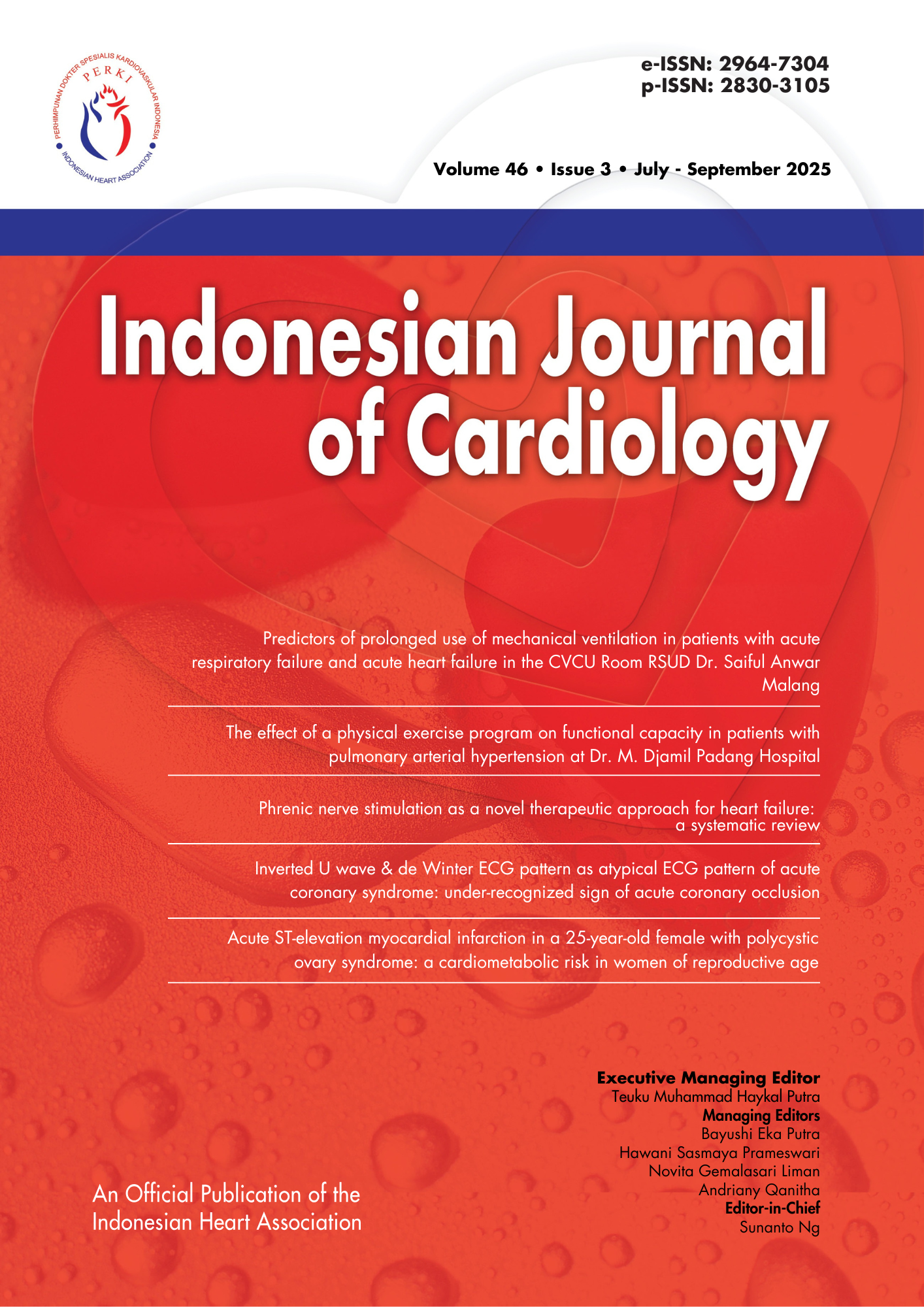Inverted U wave & de Winter pattern: under-recognized sign of acute coronary occlusion
Abstract
Background: Interpreting ECGs for evidence of ischemia in patients with noticeable changes, such as ST-segment elevation and ST-segment depression, can be easily identified. However, identifying & recognizing atypical ECG patterns of acute coronary syndrome is essential in preventing significant mortality and morbidity. In the
following case report, we describe inverted U wave & de Winter pattern.
Case Illustration: A 58-year-old male presented to the emergency department with pressure-like chest pain. His initial evaluation revealed normal blood pressure and elevated blood glucose levels, and an initial ECG was incorrectly interpreted as normal. Eight hours later, he returned with worsened chest pain. The new ECG revealed the de Winter ECG pattern, which indicates acute occlusion of the left anterior descending artery. Additionally, previously overlooked inverted U waves in the initial ECG suggested myocardial ischemia.
Eventually, the angiography revealed a complete occlusion of the proximal left anterior descending coronary artery. The patient underwent stent placement and have a good outcome
Conclusions: Inverted U wave and the de Winter pattern described in this case indicates an acute LAD occlusion. It’s a rare finding, but it is critical for emergency physicians to recognize it for urgent reperfusion therapy. Unfamiliarity with these high-risk ECG pattern may lead to delays in appropriate treatment, causing negative effects on morbidity and mortality.
Downloads
References
Ibanez B, James S, Agewall S, et al. 2017 ESC Guidelines for the management of acute myocardial infarction in patients presenting with ST-segment elevation: The Task Force for the management of acute myocardial infarction in patients presenting with ST-segment elevation of the European Society of Cardiology (ESC). Eur Heart J [Internet]. 2018;39(2):119-77. Available from: https://doi.org/10.1093/eurheartj/ehx393
Byrne RA, Rossello X, Coughlan JJ, et al. 2023 ESC Guidelines for the management of acute coronary syndromes: Developed by the task force on the management of acute coronary syndromes of the European Society of Cardiology (ESC). Eur Heart J [Internet]. 2023;44(38):3720-826. Available from: https://doi.org/10.1093/eurheartj/ehad191
Nagayoshi Y, Yufu T, Yumoto S. Inverted U-wave and myocardial ischemia. QJM: An International Journal of Medicine [Internet]. 2018;111(7):493. Available from: https://doi.org/10.1093/qjmed/hcy025
Brady W, Truwit JD, Brady W. Critical Decisions in Emergency and Acute Care Electrocardiography. [Internet]. Wiley Online Library; 2009. Available from: https://doi.org/10.1002/9781444303551.ch13
de Winter RJ, Verouden NJW, Wellens HJJ, Wilde AAM. A New ECG Sign of Proximal LAD Occlusion [Internet]. 2008;359(19):2071-73. Available from: https://doi.org/10.1056/nejmc0804737
Verouden NJ, Koch KT, Peters RJ, et al. Persistent precordial “hyperacute” T-waves signify proximal left anterior descending artery occlusion. Heart [Internet]. 2009;95(20):1701-6. Available from: https://doi.org/10.1136/hrt.2009.174557
Morris NP, Body R. The de Winter ECG pattern: Morphology and accuracy for diagnosing acute coronary occlusion: Systematic review. European Journal of Emergency Medicine [Internet]. 2017;24(4):236-42. Available from: https://doi.org/10.1097/mej.0000000000000463
Tiyantara MS, Herdianto D, Wahab A. The de Winter Pattern as Pre-Anterior ST-Elevation-Myocardial-Infarction. “An Evolution Sequence”: A Case Report. Indonesian Journal of Cardiology. 2021;42(2):58-62. doi:10.30701/ijc.1126
Wang H, Dai XC, Zhao YT, Cheng XH. Evolutionary de Winter pattern: from de Winter ECG to STEMI-A case report. BMC Cardiovasc Disord. 2020;20(1):324. doi:10.1186/S12872-020-01611-0
Prasad RM, Al-abcha A, Elshafie A, Radwan YA, Baloch ZQ, Abela GS. The rare presentation of the de Winter’s pattern: Case report and literature review. American Heart Journal Plus: Cardiology Research and Practice. 2021;3:100013. doi:10.1016/j.ahjo.2021.100013
Liu CW, Zhang JX, Hu YC, Wang L, Zhang YY, Cong HL. The de Winter electrocardiographic
pattern evolves to ST elevation in acute total left main occlusion: A case series. Annals of Noninvasive Electrocardiology. 2021;27(1):e12855. doi:10.1111/anec.12855
Ma X, Bao M. de Winter electrocardiogram pattern evolving into Wellens electrocardiogram pattern in post-percutaneous coronary intervention therapy: a case report. Eur Heart J Case Rep. 2025;9(7):ytaf139. doi:10.1093/ehjcr/ytaf139
Morris NP, Body R. The de Winter ECG pattern: Morphology and accuracy for diagnosing acute coronary occlusion: Systematic review. European Journal of Emergency Medicine. 2017;24(4):236-42. doi:10.1097/mej.0000000000000463
Rao S V, O’Donoghue ML, Ruel M, et al. 2025 ACC/AHA/ACEP/NAEMSP/SCAI Guideline for the Management of Patients With Acute Coronary Syndromes: A Report of the American College of Cardiology/American Heart Association Joint Committee on Clinical Practice Guidelines. Circulation. 2025;151(13):e771-862. doi:10.1161/cir.0000000000001309
Perhimpunan Dokter Spesialis Kardiovaskular Indonesia. Pedoman Tatalaksana Sindrom Koroner Akut. 5th Edition. Perhimpunan Dokter Spesialis Kardiovaskular Indonesia (PERKI); 2024. ISBN:978-623-6311-41-7
PDF downloads: 85
Copyright (c) 2025 Indonesian Journal of Cardiology

This work is licensed under a Creative Commons Attribution 4.0 International License.
Authors who publish with this journal agree to the following terms:
- Authors retain copyright and grant the journal right of first publication with the work simultaneously licensed under a Creative Commons Attribution License that allows others to share the work with an acknowledgement of the work's authorship and initial publication in this journal.
- Authors are able to enter into separate, additional contractual arrangements for the non-exclusive distribution of the journal's published version of the work (e.g., post it to an institutional repository or publish it in a book), with an acknowledgement of its initial publication in this journal.
- Authors are permitted and encouraged to post their work online (e.g., in institutional repositories or on their website) prior to and during the submission process, as it can lead to productive exchanges, as well as earlier and greater citation of published work (See The Effect of Open Access).





